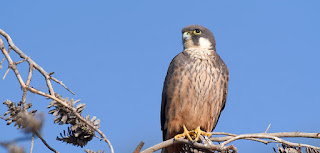Tenerife Birds
Blue Chaffinch (Photo: Public Domain)
Tenerife in the Canary Islands is a very popular destination for sun-seeking holidaymakers but it is also a great place for birdwatchers because of the variety of habitats and variety of birds. Some species are very rare ones too. Amongst the birds that are in that category is the Blue Chaffinch (Fringilla teydea), an endemic species only found in the mountain forests of the island. With its distinctive blue feathers and rarity, this is definitely one bird to watch out for.
On the subject of rare birds that can be seen in Tenerife, there are two species of laurel pigeon that only live in the laurel ("laurisilva") forests in the mountains of the island. Bolle’s Pigeon (Columba bollii) and the Laurel Pigeon (Columba junoniae) are both very limited in their range of distribution because they need this type of woodland habitat. These evergreen mixed forests that mainly consist of laurel trees were once plentiful in the Mediterranean area, but now the few patches left in the islands of Tenerife, La Gomera and La Palma are some of the only remaining stands of this form of woodland in the world.
Great Grey Shrike (Photo: Marek Szczepanek)
The Great Grey Shrike (Lanius excubitor) is an uncommon bird in the UK but can be found on Tenerife, especially on the mountains and high on Mt Teide. It is also known as a “Butcher Bird” because of its habit of impaling its prey on the thorns of bushes as a sort of makeshift larder where it can eat them later. The Great Grey Shrike feeds on beetles, grasshoppers and small animals, including lizards and mice.
Water birds
Little Egret in flight (Photo: Public Domain)
Although Tenerife has very little naturally occurring freshwater habitats, the reservoirs, ornamental ponds and irrigation tanks provide enough places for frogs and fish to live that can provide food for birds such as the Grey Heron (Ardea cinerea). The Little Egret (Egretta garzetta), with its white plumage, is a very distinctive bird that can be seen all over the island, including along its coasts and on farmland.
The Coot (Fulica atra) and the Moorhen (Gallinula chloropus) are two widely distributed water birds that both breed in Tenerife. Both species can be seen on the ponds near the village of Erjos.
One strange-looking bird you might encounter on Tenerife beaches is the Whimbrel (Numenius phaeopus). This wader has a very long bill that it uses for probing into sand and rocks where it can find its food.
The Ringed Plover (Charadrius dubius) is another wader that lives in Britain that can be also be seen in coastal areas of Tenerife, including Las Galletas and El Medano. It likes beaches and open areas of ground near the sea or by lagoons.
Birds of Prey
Kestrels (Falco tinnunculus) and Buzzards (Buteo buteo) are the two most commonly seen birds of prey that live on the island of Tenerife. The Long-eared Owl (Asio otus) hunts by night in many parts of the island. None of the birds of prey are as common as they once were.The Hoopoe
Hoopoe (Photo: Public Domain)
Canaries in the Canary Islands
Wild Canary (Photo: Public Domain)
Of course, as you might well expect the Canary Islands have canaries, and although this is not why the islands were named with their descriptive moniker, there are these types of birds living there. The Common Canary (Serinus canaria) is a bird that is very often seen and heard on Tenerife, although this wild type doesn’t have the bright yellow colouring all over its body that the the domestic version you would probably be more familiar with has. Domestic Canaries are sold in pet stores and commonly kept as pets throughout the island.
These are just some of the more interesting examples of birds that can be found in Tenerife, and that birdwatchers can be on the lookout for.





























